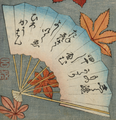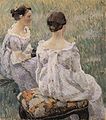Pleated blind (fabric)

Pleated ( French: folded ) is a flat textile with artificially formed folds .
history
Pleated robes have been known since ancient times and were probably considered decorative and eye-catching even then. They showed the prosperity and the social importance of the wearer. Pleated blinds are only found relatively late on compartments, curtains, lampshades, window blinds, etc.
Manufacturing
Pleated blind
Pleated woven is composed of two chains and a weft thread on weaving machines prepared with devices for tissue displacement are equipped with variable loading or shock.
The basic chain is taut, while the pleated chain is only slightly braked. After weaving a few weft threads, the weft is only allowed to cross the fold chain, the basic chain remains in the lower shed and a fold (a pleated blind) is formed over the entire width of the fabric.
The pleated effect can be enhanced by using crepe yarns or yarns of different elasticity . The fabrics are produced in all basic weaves mainly as shirt and clothing material.
Real pleated blind
Pleated blinds can be made on a warp knitting machine with three guide bars . Two rails work continuously, but the third only meshes periodically. During the stopping time of the third guide rail, a pleated fold arises next to the loosely lying threads (see picture on the right ). In order to be able to produce pleated blinds , machines must be equipped with a so-called blind laying device.
Knitted pleated blind
On knitting machines with two knitting heads a pleated caused by the binding combination of right-right and right-left. From three to four stitches in a right-left weave, a vertical strip is created which, after changing to a right-right weave, turns and forms a permanent fold in the knitted fabric . With suitable needle distribution, standing folds , lying or hollow folds can arise.
A hand-knitted pleated blind (see picture on the right ) can be made, for example: 18 stitches on the right (the first fold side), one stitch off (break), 18 stitches on the right (the second fold side), one stitch on the left (inside break between two folds). The combination is supplemented and repeated with edge stitches and decreases according to the shape of the knitted fabric.
Chemical-technical pleating
Pleating is a finishing process that consists of three operations: treatment with synthetic resin and other chemicals, folding and pressing. The pressing of yard goods is done by applying moist heat to pleating machines, smaller products are processed manually.
Permanent folds are only guaranteed for textiles made of synthetic fibers (in practice mainly made of polyester ). Wrinkles on textiles made from natural fibers are not washable.
A so-called Siroset process is used for pleating woolen fabrics . An allegedly permanent pleated blind is achieved here with concentrates of etanolamine sulfite, which contain 25% sulfuric acid.
A distinction is made between three basic types of pleats : Pleated lying pleats that are pressed in one direction, Toll pleated pleats (two-sided, mutually opposing pleated lying pleats) and standing pleated folds , which are straight, accordion-like and standing folds. This further shapes can be combined as Sonnenplissees , radiating with those around circumferential Stehplisseefalten from waist to hem become wider, or Bahnenplissee , a combination of narrow and wide Plisseearten.
Pleated blinds - a popular sun protection textile
A pleated system consists of a special sun protection textile with integrated, permanent folds. This can be pushed together like an accordion onto a narrow package or pulled apart to partially or completely cover the window. The fabric is attached to narrow rails at the top and bottom and is guided using a special cord technique
gallery
literature
- Hennig et al. Coll .: tissue technology , VEB Fachbuchverlag Leipzig 1978
- Kießling / Matthes: Textile specialist dictionary , ISBN 3-7949-0546-6 , Berlin 1993
- Mon Tricot & Plus Lexicon , Ediclair & Cie, Paris 1980










